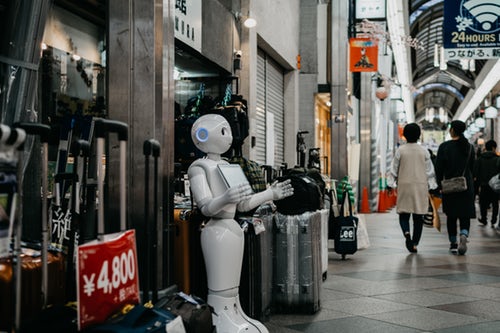With the trend of advancement, a range of new products and competitive enterprise deployments, artificial intelligence is creating a storm in the Internet of Things (IoT). Companies are willing to top in the race by drafting strategies for IoT, reviewing more projects on IoT and receiving more values from the current IoT deployment using AI. With the basic understanding of flow diagrams along with trends and predictions, the AI and IoT help get the clear idea for the further research. Sometimes AI and IoT are interpreted as the wide concepts and so we provide brief definitions for the same.
Internet of Things
Embedded technology of the physical objects that are networked for communication within their internal or external workspace.
Artificial Intelligence
It is a field of computer science dealing with the machines given by presuming they have the ability of human intelligence.
IoT is becoming smarter and so does the companies. They have started incorporating artificial intelligence into the applications built using IoT to get the insights of the data. By incorporating IoT with AI, the startup funds for an IoT project are growing faster as they are positioned on the peak. Huge companies across varied industries are beginning or already proceeded to explore the mix of AI and IoT to offer new services and operate more efficiently the service providers for IoT – Amazon, IBM, Microsoft, and Oracle are integrating AI capabilities.
There are different reasons and advancements to use the combined approach of IoT and AI.
AI with IoT is progressive
IoT applications and deployments are greatly influenced by Artificial Intelligence. Whether it is a small investment or a startup, the companies that have begun to merge IoT with ai has achieved a greater success over the past years. Major of the IoT service providers now offers integrated AI applications based on machine learning analytics. The reason behind the growth of AI is its ability to quickly fetch the insights from the data. The IoT platform software provides machine learning based analytics which is a part of AI to identify the patterns and figure out anomalies in the data generated by the smart sensors and devices- data alike pressure, air quality, vibration, and sound. As compared to the traditional business tools, AI can accurately predict operational demands for the companies 20 times faster.
Avoid Downtime
In a huge number of sectors, to name two – offshore oil and gas or manufacturing industries can have a huge impact of the unplanned downtime which results in big money. With the combo approach of AI and IoT, predictive maintenance can be done using the analytics to predict the equipment failure before the time to run smoothly. It helps to eliminate the damage done to the economics of unplanned downtime. AI has the ability to identify the patterns in the constant stream of data from all the types of machinery to aware of machine failure.
Rise in Efficiency
AI empowered IoT also helps in increasing the operational efficiency. The predict equipment failure by machine learning can also predict the operational conditions and parameters necessary to maintain the outcome by gulping a constant channel of data in order to detect invisible patterns. It helps in identifying the fraud risk so as to avoid the future downtime. All these predictions and identifications lead to higher operational efficiency.
Improved products and Services
IoT enhanced AI helps to create new products and services. AI impacted Natural Language processing techniques are getting better at letting the machines speak rather than occupying a human operator. Drones and Roberts which are AI controlled also brings new trends for monitoring and inspection like never before. Fleet-footed management of the commercial vehicles is made possible through the AI. It can monitor every valuable data point in the planes, trains, trucks, and automobiles in searching the efficient route to avoid unplanned downtime.
Risk Management
A vast number of applications running on a combined approach of AI and IoT is helping companies to predict risks as well as understand for the quick response by enabling the worker safety, money loss, and cyber threats. Already there are many applications which are currently in use for the fraud detection at ATMs to predict the risky stress conditions for workers and monitoring surveillance data for law enforcement to identify the crime pictures over the time.
Enterprise Applications
For better openings and smooth operations, enterprises across the industries are striving harder to use AI-IoT approach for giving tough competition in business performance. Predictive capabilities of machine learning are integrated with the service providers like Microsft Azure IoT, IBM Watson IoT, and GE Predix. A large number of IoT solutions and bundles take advantage of AI technology. It is also possible to use AI technology with the products even if it was not created with the ai in mind.
Possible future used of IoT empowered AI Equipments
#1 Security devices
Companies have started using the key fob technologies in terms of pure IoT applications to unlock the doors and other equipment. It is also useful to the companies having hundreds of employees for detecting the fraud patterns or any other kind of suspicious activity. The key fob technology also helps to access locations in bigger firms and this may provide better security insights. Security systems are enabled with the fingerprints which provide a high-level safeguard against theft. Such unique identification systems are currently in demand around the globe.
#2 Face Recognition
This area has a very wide impact on the overall industries. It is highly used and most accurate technology by the AI to reduce the risks. Companies have started its input in marketing applications. Also, it is used in many mobile devices to unlock the cell which ensures higher security of the information. Similar is the system of Facebook’s auto-tagging where you upload a picture and it automatically asks to tag people by detecting their face.
#3 Automotive Industries
These industries have incorporated work into incredible technology by adapting cruise control and self-driving vehicles to make safer vehicles by helping them with the communication and providing data in the present time where errors and accident occur at a high pave. This helps in dealing with traffic controlling and also advances the people against the route they wanna take to reach the safest and earlier.
#4 Hospital Monitoring
Machine learning provides a better way to reduce the time and space complexity when it comes to the healthcare sector. It allows the doctors to monitor the health of the patient by using personalized monitoring devices which predicts the future disease ahead of the time. This enhances the patient’s health assurance by identifying future diseases.
#5 Automate Recommendations
Nowadays, online shopping has become a tend and to be on top the websites have started to provide personalized suggestions on the basis of the previous shopping or purchased item. This is the strategy used for boosting sales and marketing while it also reduces the hustle for the customer. This technique allows to showcase their new products and also increase its demand.
#6 Industrialized Internet of Things (IIoT)
The vast use of IoT devices with industrial equipment generates a plethora of data. With the use of AI algorithms applied to the bunch of data, business owners can figure out possible issues and fix them in advance by applying the insights to other cases. The systems are taught to find out internal and external factors that have a huge impact on the machine operations. Resource optimization and rise in industrial safety are streamlines for the entire production process. Among this, the predictive maintenance is the brightest show-stealer of AI which is implemented in IIoT. The system can predict the maintenance of the plant floor by using AI algorithms which can help in creating self-healing IoT devices like transmitters and sensors.
Bottom Line
Artificial intelligence has reached a point where it can provide speeding up tasks performed by the people which were once done by the computers. It is certainly going beyond the self-driving cars and aircraft to function the whole world on its application. IoT is a stress-reducing agent for the bulk of data generated. Many organizations are struggling to track and maintain this huge amount f the data. ASO, in conclusion, the Internet of Things is the flow of the data between devices and to figure out solutions from this data you require the Artificial Intelligence.
While IoT is very great, it truly doesn’t add up to much without a decent AI framework. The two innovations need to achieve a similar dimension of advancement with the end goal to work as superbly as we trust they ought to and would. Researchers are attempting to discover approaches to make more wise information investigation programming and gadgets with the end goal to make protected and viable IoT a reality. It might require some investment before this happens in light of the fact that AI advancement is lingering behind IoT, yet the likelihood is, by and by, there.
Coordinating AI into IoT systems is turning into an essential for achievement in the present IoT-based advanced biological systems. So organizations must move quickly to distinguish how they’ll drive an incentive from joining AI and IoT—or face playing makes up for lost time in years to come. The best way to stay aware of this IoT-created information and gain the shrouded experiences it holds is utilizing AI (Artificial Intelligence) as the impetus of IoT.
Author Bio:
Herman Morgan is a Business Analyst at Tatvasoft.com.au, a Software development company in Melbourne. He is having 3 years of experience as a Business Analyst in a Technological domain. Follow Me on Twitter.


